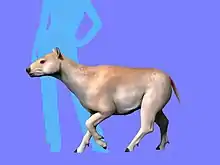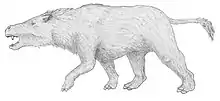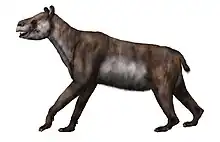| Uruguayodon Temporal range: | |
|---|---|
| Scientific classification | |
| Domain: | Eukaryota |
| Kingdom: | Animalia |
| Phylum: | Chordata |
| Class: | Mammalia |
| Order: | †Litopterna |
| Family: | †Proterotheriidae |
| Genus: | †Uruguayodon Corona et al., 2019[1] |
| Species: | †U. alius |
| Binomial name | |
| †Uruguayodon alius Corona et al., 2019[1] | |
Uruguayodon is an extinct genus of proterotheriid from the middle Pleistocene of Uruguay. It is known from the type and only species U. alius, named by Corona and colleagues in 2019 for dentaries and a partial postcrania from the Raigón Formation. Uruguayodon represents one of the latest occurrences of Proterotheriidae, with only Neolicaphrium representing other remains from the Pleistocene to possibly Holocene.[1]
Description
This animal would have been very similar to other proterotheriids, such as Anisolophus or Diadiaphorus. Uruguayodon possessed slender and elongated legs, equipped with three toes (the middle one of which was well developed). The skull was equipped with a rather short and high snout, with fairly elongated nasal bones. The molar had closely spaced internal tubercles but, in contrast to Anisolophus, the last lower molar was characterized by paraconid and paralophid in a lingually peripheral position; the metaflexis was smooth and there was no entoflexis.
Classification
Uruguayodon was described in 2019, based on fossil remains found in Uruguay, in the San José member of the Raigón Formation. Another mammal has been found in the formation, Charruatoxodon, a toxodontid notoungulate described in 2022.[2] The fossils of Uruguayodon had previously been ascribed to the genus Anisolophus, but a redescription allowed them to be attributed to a new genus and species. Uruguayodon is a derived member of the Proterotheriidae,[3] a group of litoptern mammals, which during the Cenozoic developed evolutionary convergence with the equids, particularly with regards to their legs. Uruguayodon is the second known proterotheriid known from the Pleistocene, after Neolicaphrium.
Below is a phylogenetic tree of the Proterotheriidae, based on the work of McGrath et al. 2020, showing the position of Uruguayodon.[3]
| Proterotheriidae |
| |||||||||||||||||||||||||||||||||||||||||||||||||||||||||||||||||||||||||||||||||||||||||||||||||||||||||||||||||||||||||||||||||||||||||||||||||||||||||||||||||||||||||||||||||||||||||||||||||||||||||||||||||||||||||||||||||
References
- 1 2 3 Corona, A.; Perea, D.; Ubilla, M. (2019). "A new genus of Proterotheriinae (Mammalia, Litopterna) from the Pleistocene of Uruguay". Journal of Vertebrate Paleontology. 39 (1): e1567523. Bibcode:2019JVPal..39E7523C. doi:10.1080/02724634.2019.1567523. S2CID 145907219.
- ↑ Ferrero, B.S.; Schmidt, G.I.; Pérez-Garcia, M.I.; Perea, D.; Ribeiro, A.M. (23 February 2022). "A new Toxodontidae (Mammalia, Notoungulata) from the Upper Pliocene-Lower Pleistocene of Uruguay". Journal of Vertebrate Paleontology. 41 (5): 1–12. doi:10.1080/02724634.2021.2023167. S2CID 247089081.
- 1 2 McGrath, Andrew J.; Anaya, Federico; Croft, Darin A. (2020). "New proterotheriids (Litopterna, Mammalia) from the middle Miocene of Quebrada Honda, Bolivia, and trends in diversity and body size of proterotheriid and macraucheniid litopterns". Ameghiniana. 57 (2): 159–188. doi:10.5710/AMGH.03.03.2020.3268. S2CID 216236954.
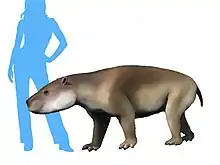
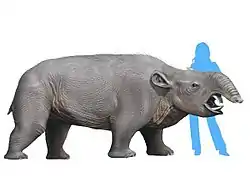

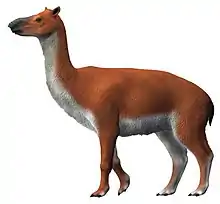
.jpg.webp)
